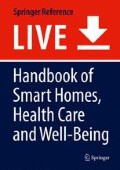Abstract
The combination of ubiquitous computing and wireless communication has provided the opportunities to create novel solutions to realize smart environment. The application of smart environments in the field of health care and assisted living is accelerating at a high pace. These systems can provide cost-effective solutions that will improve the quality of life of humans, particularly those regarded as senior citizens or have some form of disability. The realization of smart environments with real-time monitoring will enable such people to lead independent lives in the comfort of their normal homes. This chapter focuses on highlighting the major components and systems that are currently available to deliver reliable technological solutions for smart homes, health care, and well-being. The key sensing devices that form the basis of smart environments are discussed. The integration of these devices into wireless sensor networks (WSNs) that can be spread over an area to build smart health and assisted living environments is investigated. The role of power line communication technologies, which complements wireless communications, and the new reliable solutions is also highlighted. Wireless communication technologies and the various options and standards available are discussed. Target localization plays a key role in many of the services supported by smart environments. The various fundamental localization techniques are investigated. The major security and privacy issues related to WSNs and wearable body area networks (WBANs) and their impact on the trust in using such systems are addressed. A case study that demonstrates the integration of various WSNs elements to deploy a guiding system for blind persons is described.
References
Al Ameen M, Liu J, Kw K (2012) Security and privacy issues in wireless sensor networks for healthcare applications. J Med Syst 36(1):93–101
Al-Qutayri M, Jeedella J, Al-Shamsi M (2011) An integrated wireless indoor navigation system for visually impaired. In: Systems conference (SysCon), 2011 I.E. international, Montreal
Astely D, Dahlman E, Fodor G, Parkvall S, Sachs J (2013) LTE release 12 and beyond [Accepted from open call]. IEEE Commun Mag 51(7):154–160
Blueooth [Online]. Available: http://www.bluetooth.com. Geopend 8 Dec 2013
Chen M et al (2011) Body area networks: a survey. Mob Netw Appl 16(2):171–193
Chipara O, Lu C, Bailey TC, Roman G-C (2010) Reliable clinical monitoring using wireless sensor networks: experiences in a step-down hospital unit. In: Proceedings of the 8th ACM conference on embedded networked sensor systems, New York
Di Pietro R, Viejo A (2011) Location privacy and resilience in wireless sensor networks querying. Comput Commun 34(3):515–523
Domingo MC (2012) An overview of the Internet of Things for people with disabilities. J Netw Comput Appl 35(2):584–596
Home Plug Alliance [Online]. Available: https://www.homeplug.org/home/. Accessed 12 Nov 2013
Hu W et al (2009) Secfleck: a public key technology platform for wireless sensor networks. In: Wireless sensor networks. Springer-Verlag, Berlin/Heidelberg, pp 296–311
Intille SS, Larson K, Beaud JS, Tapia M, Kaushik P, Nawyn J, McLeish TJ (2005) The PLACELAB: alive-in laboratory for pervasive computing research (VIDEO). In: Pervasive computing, third international conference, Munich, Germany PERVASIVE 2005
Jeon J (2002) A survey on protocols for home networks based on power line communication. In: Proceedings on the 15th CISL winter workshop, Kushu
Kaseva V, Hämäläine TD, Hännikäinen M (2011) A wireless sensor network for hospital security: from user requirements to pilot deployment. EURASIP J Wirel Commun Netw 17 http://dx.doi.org/10.1155/2011/920141
Kim H-C, Meng Y, Chung G-S (2011) Health Care with Wellness Wear, Health Management - Different Approaches and Solutions, Dr. Krzysztof Smigorski (Ed.), ISBN: 978-953-307-296-8, InTech, DOI: 10.5772/19875. Available from: http://www.intechopen.com/books/health-management-different-approaches-and-solutions/health-care-with-wellness-wear
Krontiris I, Benenson Z, Giannetsos T, Freiling FC, Dimitriou T (2009) Cooperative intrusion detection n wireless sensor networks. In: EWSN ‘09 proceedings of the 6th European conference on wireless sensor networks, Berlin
Kupershtein E, Wax M, Cohen I (2013) Single-site emitter localization via multipath fingerprinting. IEEE Trans Signal Process 61(1):10–21
Li M, Lou W, Ren K (2010) Data security and privacy in wireless body area networks. IEEE Wirel Commun 17(1):51–58
Malan D, Fulford-Jones T, Welsh M, Moulton S (2004) CodeBlue: an ad hoc sensor network infrastructure for emergency medical care (2004). In: International workshop on wearable and implantable body sensor networks
Matyas V, Kur J (2013) Conflicts between intrusion detection and privacy mechanisms for wireless sensor networks. IEEE Secur Priv 11(5):73–76
Nunes RJC (2003) Home automation – a step towards better energy management. In: International conference on renewable energies and power quality (ICREPQ03), Vigo
Pantelopoulos A, Bourbakis NG (2010) A survey on wearable sensor-based systems for health monitoring and prognosis. IEEE Trans Syst Man Cybern Part C Appl Rev 4(1):1–12
Rohokale VM, Prasad NR, Prasad R (2013) Reliable and secure cooperative communication for wireless sensor networks making use of cooperative jamming with physical layer security. Wirel Pers Commun 73:595–610
Viani F, Robol F, Polo A, Rocca P, Oliveri G, Massa A (2013) Wireless architectures for heterogeneous sensing in smart home applications: concepts and real implementation. Proc IEEE 101(11):2381–2396
Wood AD, Stankovic JA et al (2008) Context-aware wireless sensor networks for assisted living and residential monitoring. IEEE Netw 22(4):26–33
Zhu WT, Xiang Y, Zhou J, Deng RH, Bao F (2011) Secure localization with attack detection in wireless sensor. Int J Inf Secur 10:155–171
Zigbee Alliance [Online]. Available: http://www.zigbee.org. Geopend 8 Dec 2013
Author information
Authors and Affiliations
Corresponding author
Editor information
Editors and Affiliations
Rights and permissions
Copyright information
© 2014 Springer International Publishing Switzerland
About this entry
Cite this entry
Jeedella, J.S.Y., Al-Qutayri, M. (2014). Technological Solutions for Smart Homes. In: van Hoof, J., Demiris, G., Wouters, E. (eds) Handbook of Smart Homes, Health Care and Well-Being. Springer, Cham. https://doi.org/10.1007/978-3-319-01904-8_47-1
Download citation
DOI: https://doi.org/10.1007/978-3-319-01904-8_47-1
Received:
Accepted:
Published:
Publisher Name: Springer, Cham
Online ISBN: 978-3-319-01904-8
eBook Packages: Springer Reference EngineeringReference Module Computer Science and Engineering

